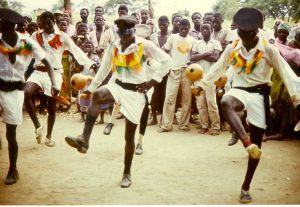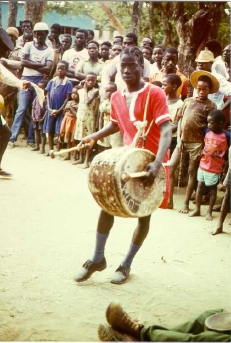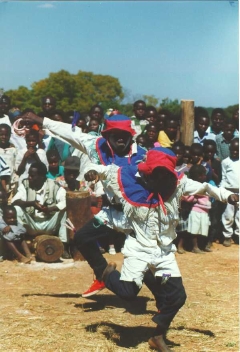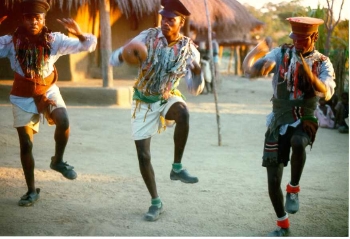Traditional Dance among the Tumbuka of Zambia by Mwizenge S. Tembo, Ph. D.
Contents [hide]
- 1 Mganda (view on YouTube)
- 2 How to Dance Mganda
- 3 The Origin of the Mganda Dance
- 4 Characteristics OF Zambian Traditional Dances
- 5 Functions of Mganda
- 6 References
Mganda (view on YouTube)
Synchronizing their movements with the louder and more powerful drumming, the dancers vigorously go through dazzling movements somewhat depicting military like drills, then they swing around injecting some of the African traditional rhythmic gyrating movements. All the while the dancers use whistles to accentuate and time some of the smoothly choreographed movements. This explosion of intense action and energy might last up to a few minutes depending on the length and sequence of the steps of the dance. Then there is a lull in the dance as the performers slow down to start the cycle again by singing the song or starting a new one. It is at this time, that young beautiful women using their clean well pressed handkerchiefs, might wipe the sweat off the brow of a particular drummer or dancer. This is every young dancer’s dream. Individual members of the audience may also place small sums of money in a particular dancer’s palm as a reward for his good or particularly outstanding dancing during a preceding sequence. This is known as kusupa.

Music and dance are perhaps the most universal of the creative nature of humans. Rural traditional people of Zambia are no exception. In spite of the dramatic social changes that have influenced many urban dwellers, Zambian rural people have maintained their traditional dance and music.
What would you do for entertainment on a Sunday afternoon if you did not have the movie theater to go to, open air rap concerts to attend, the VCR to watch a video movie, or TV to watch sports? If you lived eight thousand miles away among the Tumbuka, you would either be watching or dancing the mganda. I encountered the fascinating mganda dancers when I was travelling in the Lundazi rural district in Zambia. Traditional Zambian dance has not remained static. The people have adapted to modern influences thereby incorporating modern styles and synthesizing them with the traditional ones. One such excellent example is that of the mganda dance common among the Tumbuka people of the Lundazi district of the Eastern Province of rural Zambia. As is common in most of Africa, the Tumbuka straddle the international boundary between Zambia and Malawi. This is why the mganda dance is also common in parts of Northern Malawi.
How to Dance Mganda

Each group of mganda dancers from a village usually select a Jitedi which is a Tumbuka derivation from the English adjudicator. This is the leader of the team who acts almost as a conductor and has the most prestige. Once the dancers arrive at an open-air spot where they are going to perform, they form lines in rows ranging from three to five. The dancers are all neatly dressed in uniform colorful clothes. The audience makes a circle around them. The Jitedi will make sure the drummers are ready, that everyone has a baja, which is a kazoo made out of dry gourd and a white thin spider’s membrane. The Jitedi will also make sure the young men with sticks are ready and that a number of members of the dancing team have whistles.
The dance starts with moderate drumming, and then a song, which might have the following lyrics:
Anya Mu Nyirongo, Anya Munyirongo, Yahole-e-e
Mwadabila bele Yahole-e-e
Mwadabila bele Yahole-e-e
Lady Nyirongo, Lady Nyirongo
You admire your breasts
You admire your breasts
The lyrics are about a young beautiful woman whose name is Nyirongo who has so much vanity that she admires her own breasts. The song is then sung by the dancers again using bajas. The singing might take up to five minutes building a sense of anticipation in the audience. Then the climax of the dance follows. Most dancers experience ecstasy during this stage of the dance as though they were in an all consuming trance as this mganda dancer shows at Mwase mphangwe about forty miles south of Lundazi.
Like many other countries of the world, Zambia has many traditional dances. In each of the nine provinces there might be up to five major dances spread over several tribes. Some of the major characteristics of the dances are that they are performed either by men or women, some are for pure recreation while others are for exorcizing evil spirits or initiating of girls into womanhood. Some of the dances are old and others relatively new in that they came to being with the arrival of European influence barely forty to fifty years ago. The lyrics of the music are a commentary on significant social and political events of the time and therefore reflect the indigenous people’s perspectives. All these dynamic characteristics reflect part of the richness and complexity of African cultural traditions. Much of this traditional music now forms the basic foundations of most modern and contemporary African rhythms which are enjoyed world over.
The Origin of the Mganda Dance

The mganda dance is a classic case of the creative capacity of human beings. Britain, up to October 24, 1964 was a colonial power in the then Northern Rhodesia. During the Second World War, many young men among the Tumbuka were conscripted into the army to fight on the side of the British. The young men fought in North Africa and in places like Burma in Asia. The men came back to the villages with new knowledge about military uniforms, yelling commands, parades, drills, whistles, carrying and use of rifles. All these new experiences inspired the birth of a new dance; the mganda. The name of the dance is derived from the Tumbuka language term ganda which means “to march like soldiers.” The name of the dance is also depicts the loud boom sound from the large marching band style drum that is used during the dance. The dance is also sometimes known as malipenga or trumpets. Lipenga or plural malipenga are an equivalent of Western trumpets used in marching bands. The equivalent traditional instruments known as baja or kazoos were first used by the lake side Tonga of Northern Malawi.
The mganda synthesized some of the traditional rhythmic dance movements with modern military drill-like movements. The product was a dance that incorporates the vigorous energetic synchronized movements of young men who use two and a half foot swagger sticks mimicking the handling of rifles in an army drill. There are also older men who have more gentle relaxed movements. When all of this is mixed with the drumming, unique traditional instruments known as baja, a kazoo made out of dry gourd, songs with traditional lyrics, African rhythm, ambience and festive atmosphere, you have tremendous electricity, excitement, and sheer enjoyment.
Characteristics OF Zambian Traditional Dances
Like many other facets of traditional customs, practices and lifestyles anywhere in the world, modern experiences have influenced Zambian traditional dance and music. Before the advent of European colonialism, Zambian traditional dance and music follows an distinctive typical cycle. The dances first involve a sequence of singing usually accompanied by synchronized clapping, and soon after the climax of the dance. Musical instruments usually include a number of different types and sizes of drums and other percussions like the shaking of gourds with dry seeds in them and rattles. The dance climax involves a wide repertoire of vigorous or elegant body movements. The dancers might stomp their feet harder, gyrate their hips sensuously or seductively, swing their arms from side to side while initiating graceful jerking movements of the head and neck like a swan. After the climax, the dancers resume the singing starting a new cycle.

The majority of traditional Zambian dances are done in the open with performers in the middle, and the drummers, singers, and other instrument players and audience forming a circle around the dancers. What is most exciting is that Zambian traditional dance is so participatory that the distinction between the audience and performers is constantly blurred. For example, the entire audience often participates in the singing. If a drummer is tired another individual who was standing in the audience would take over to relieve the tired individual. No one individual is ever credited with composing any one of the numerous songs used during all types of dances.
The mganda dance is performed for recreation between May and November, which is the dry season when there is no farming. Nowadays, the mganda dance involves young men in a particular village, practicing, and rehearsing outside the village during the week. Mganda might sometimes be performed on a competitive basis “on an away and home match basis.” On a mutually agreed afternoon, the group of young men and might walk up to 20 miles to perform at another rival village during a Sunday afternoon. In some cases, the dancers might have a tour during which they will walk many miles and perform at different villages along the way.
Functions of Mganda
The mganda dance is popular among the Tumbuka because it plays so many functions. The dance integrates very well what is new and traditional among the Tumbuka. It is an excellent Sunday afternoon entertainment for the people and engenders healthy competition among young dancers from different villages. The dance is especially a good medium for social commentary and provides a valuable social opportunity for young men and women from different villages to meet, interact, know and admire each other. Quite often, a young man and woman who marry might have first seen or met each other at a mganda dance.
The mganda dance is a means of social commentary. In communities in which the rate illiteracy is still high and people have no access to newspapers, radios and other modern mass media through which they could express themselves on current issues in their communities, the mganda dance provides such a popular forum. The dance routines and many song lyrics often manifest such commentary. For example, a particular song and dance routine might portray and criticize a polygamous man who shows unfair attention and love to a younger junior wife.
The mganda dance is also a channel for community and individual artistic self expression that depict elements of joy, confrontation, political and social caricature and mimicry of the past and present expressed in the song lyrics and especially dance routines.
Perhaps one of the most significant functions is that the mganda dance among the Tumbuka encourages healthy competition among communities and bodily cleanliness. Dancers have to be clean and neatly dressed. They are judged by the public and spectators on how clean and well groomed their bodies are and how well their uniform clothes were ironed. All of these functions create a sense of community and belonging, which are very important in creating community vitality among the Tumbuka of Zambia.
References
J. Clyde Mitchell, “The Kalela Dance: Aspects of Social Relationships among the Urban Manchester, Manchester University Press, 1956.
Gulliver, Pamela., Africans in Northern Rhodesia,” The Rhodes-Livingstone Papers N0. 27, Dancing Clubs of the Nyasa in Tanganyika: Notes and Records, 1951.
Jones, A.M., “The Mganda Dance”, (Bantu) African Studies, Vol. 4, N0. 4, 1945.
Kay, George., “Chief Kalaba’s Village: A Preliminary Survey of Economic Life in an Ushi Village, Northern Rhodesia,” The Rhodes-Livingstone Papers, N0. 35, 1964.
Ngulube, Naboth M.J., Some Aspects of Growing Up in Zambia, Lusaka: Nalinga Consultancy/SOL – Consult A/S Ltd., 1989.
Ranger, T.O., Dance and Society in Eastern Africa, Heinemann, 1975.
Republic of Zambia, Country Profile: Zambia 1984, Lusaka: Central Statistical Office, 1984.
Skjonsberg, Else., The Kefa Records: Everyday Life Among Women and Men in a Zambian Village. (Oslo: U-Landsseminaret, No. 21, 1981).
Tembo, Mwizenge S. Titbits for the Curious, Lusaka: Multimedia Publications, 1989.
Tembo, Mwizenge S., Mwila, Chungu., and Hayward, Peter., An Assessment of Technological Needs in Three Rural Districts of Zambia, Lusaka: Institute for African Studies, February 1982.
The American University, Zambia: a Country Study, Edited by Irving Kaplan, Washington, D.C , 1979.
University of Pennsylvania Museum, Dances of Southern Africa, film, 1960.